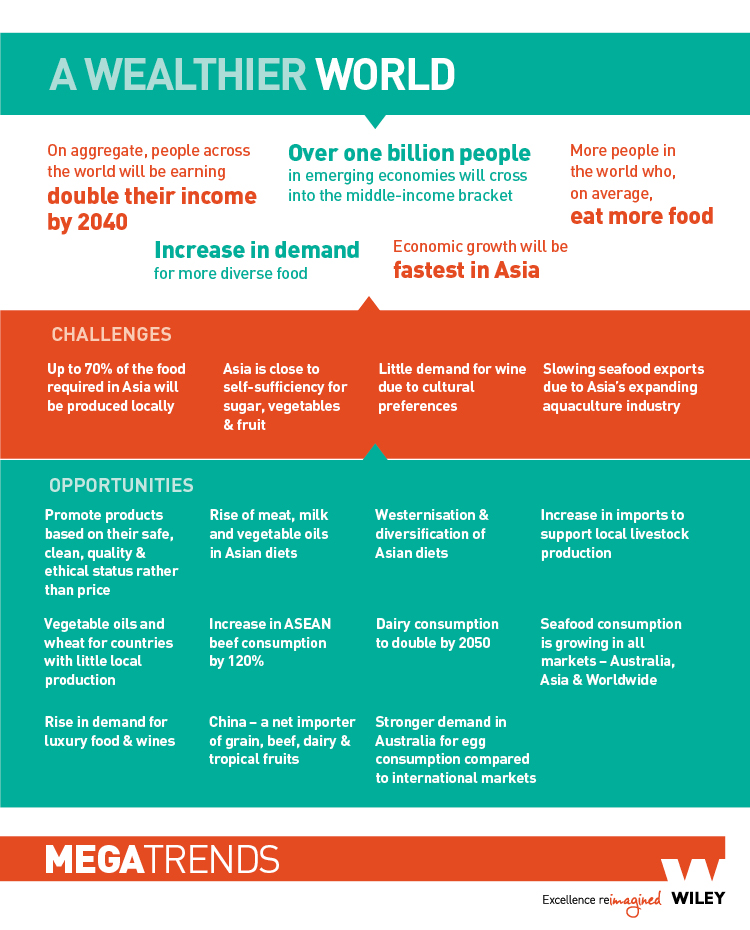Recently, CSIRO in conjunction with the Rural Industries Research and Development Corporation (RIRDC) released the Rural Industry Futures report. Five “megatrends” were identified in the report that will affect the Agribusiness industry in the coming 20 years with a particular focus on the opportunities within Asian markets.
The unique challenges and opportunities presented by the second megatrend are summarised below.
“A Wealthier World”
Income growth rates will be higher within the economies of East Asia, Latin America and the Middle East which are forecasted to grow at rates two to three times faster than their more developed neighbours. This rapid income growth will result in more than one billion people in developing countries crossing the boundary from poverty into the middle-income bracket.
As noted in the previous megatrend “a hungrier world”, up to 30% of the 60-70% required increase in food production can be attributed to income growth. The reason for this is that as people cross the poverty line into a higher income bracket they can spend up to 80% of their disposable income on food. Asian consumers will not just increase their daily intake of food, but also the quality and diversity of their food choices.
Challenges:
The combining factors of an increase in demand for food and a quickly growing economy will result in many of these available opportunities being capitalised on by the local businesses of developing nations. In Asia for instance, up to 70% of the food required will be produced locally. Sectors such as sugar, and some vegetables and fruit are close to self-sufficiency; while the local aquaculture industry is expanding, reducing the potential for increased imports from countries such as Australia.
The advance of Asia’s local industry will lead to an increase in the number of competitors in the market who may in some sectors have an advantage over more developed countries in categories such as cost due to their comparatively low-cost infrastructure.
Opportunities:
The opportunities presented by the “wealthier world” megatrend are many and diverse. Multiple sectors within the Agribusiness industry will have the potential to take advantage of these opportunities as Asian diets diversify and become more aligned with western diets.
The consumption of meat, seafood, dairy, fruit and vegetable products will increase. Beef consumption in the ASEAN region is expected to increase by 120% and dairy consumption is expected to double by 2050. China in particular is establishing itself as a net importer of beef, dairy and tropical fruits.
Delicacies and luxury foods and wines such as tropical fruits, nuts, boutique wines and champagne will become more popular as average incomes across Asia increase. For instance, the importation of Bananas, considered a delicacy in China, has increased from 75 thousand tonnes in 1993 to 1 million tonnes in 2011. China’s share of world champagne imports has also increased from 0.1% to 0.3%.
Summary
The five megatrends identified in the Rural Industries Futures report provide an insight into the significant market opportunities and challenges within Asia in the coming years.
Population and income growth will lead to increased demand for a higher quantity of more diverse and quality products. Consumers will be more informed and more empowered to make choices based on personal values rather than price. Advances in technology will lead to greater efficiencies in production and the risk associated with climate change and extreme weather events will lead to the emergence of entirely new markets.
The Australian Agribusiness sector is positioned for growth and the developing nations of Asia will be a key component. The industry needs to capitalise on the ‘clean and green’ image of Australia as well as available technologies to communicate and build a relationship and social presence with their customers. Emerging technologies need to be adapted to address the unique challenges presented by our climate and available resources. The extent by which the Australian Agribusiness industry can take advantage of the market opportunities presented by these megatrends largely comes down to their ability to adapt and innovate.
The full copy of the Rural Industry Futures Report can be downloaded on the RIRDC website.
We will be releasing the Third Megatrend on Friday: Part Three – Choosy Customers




